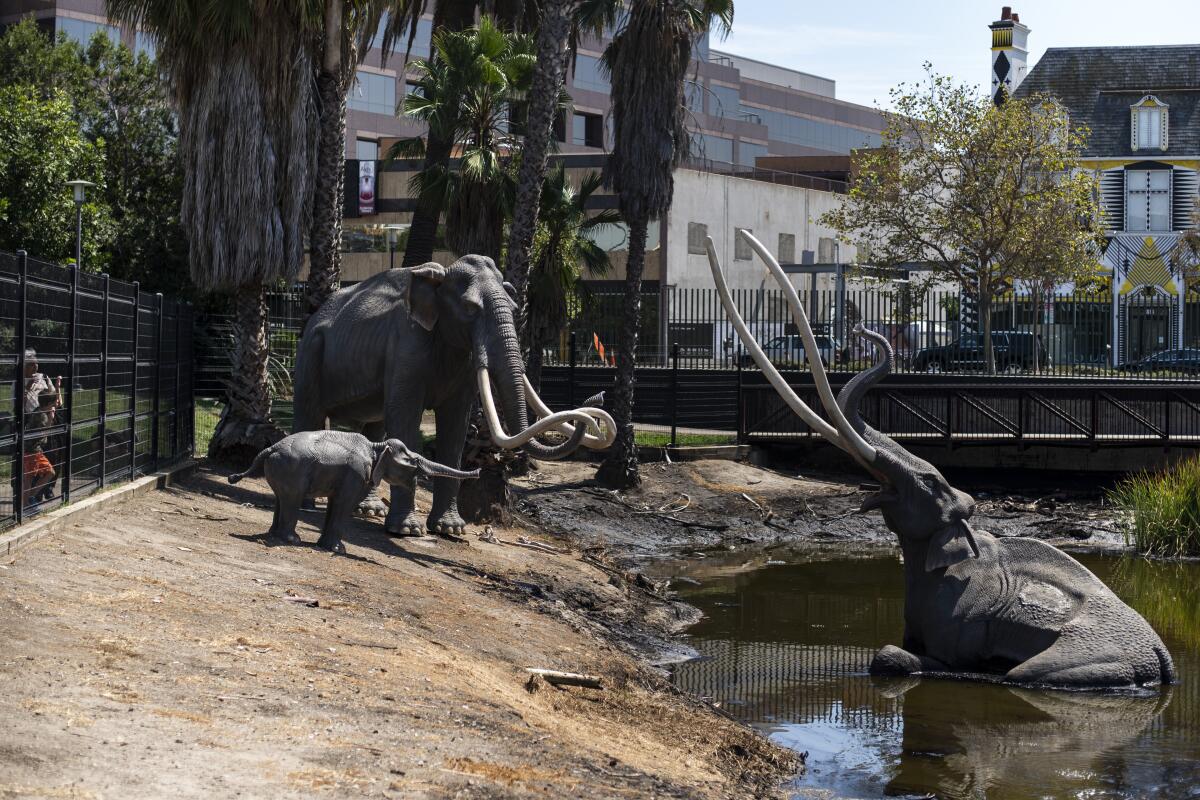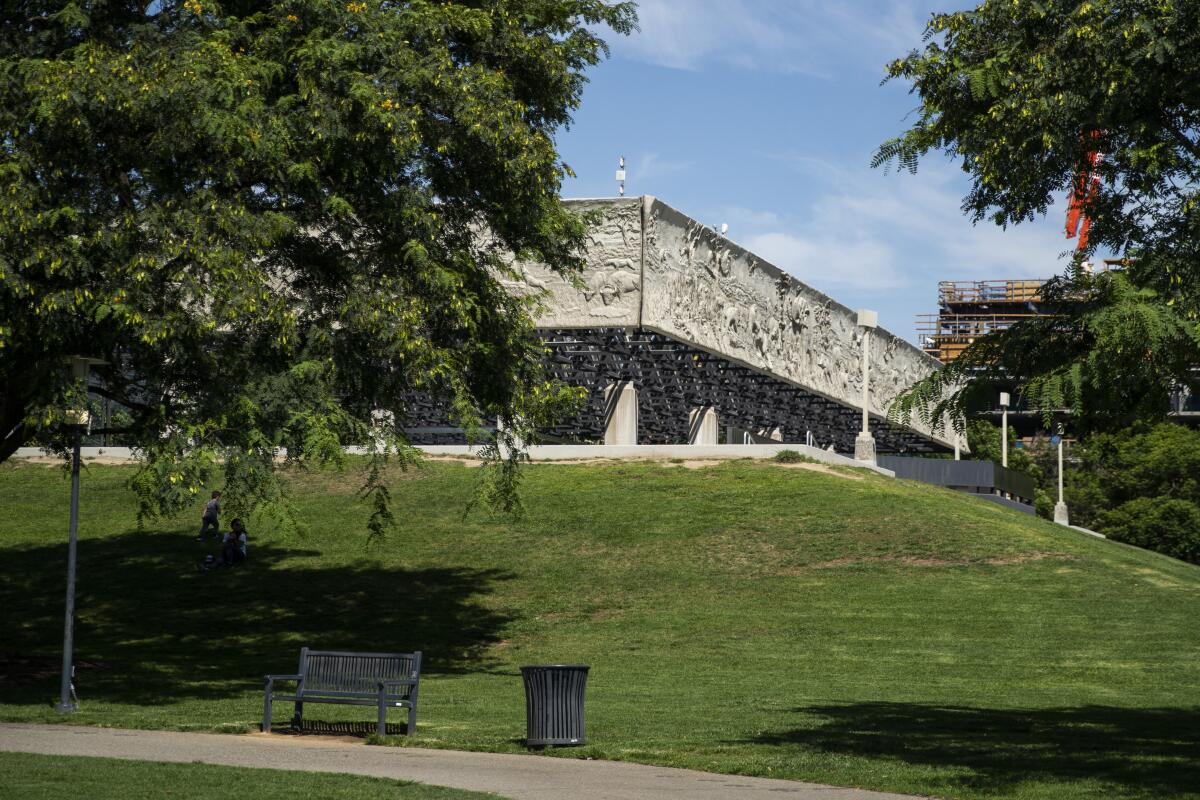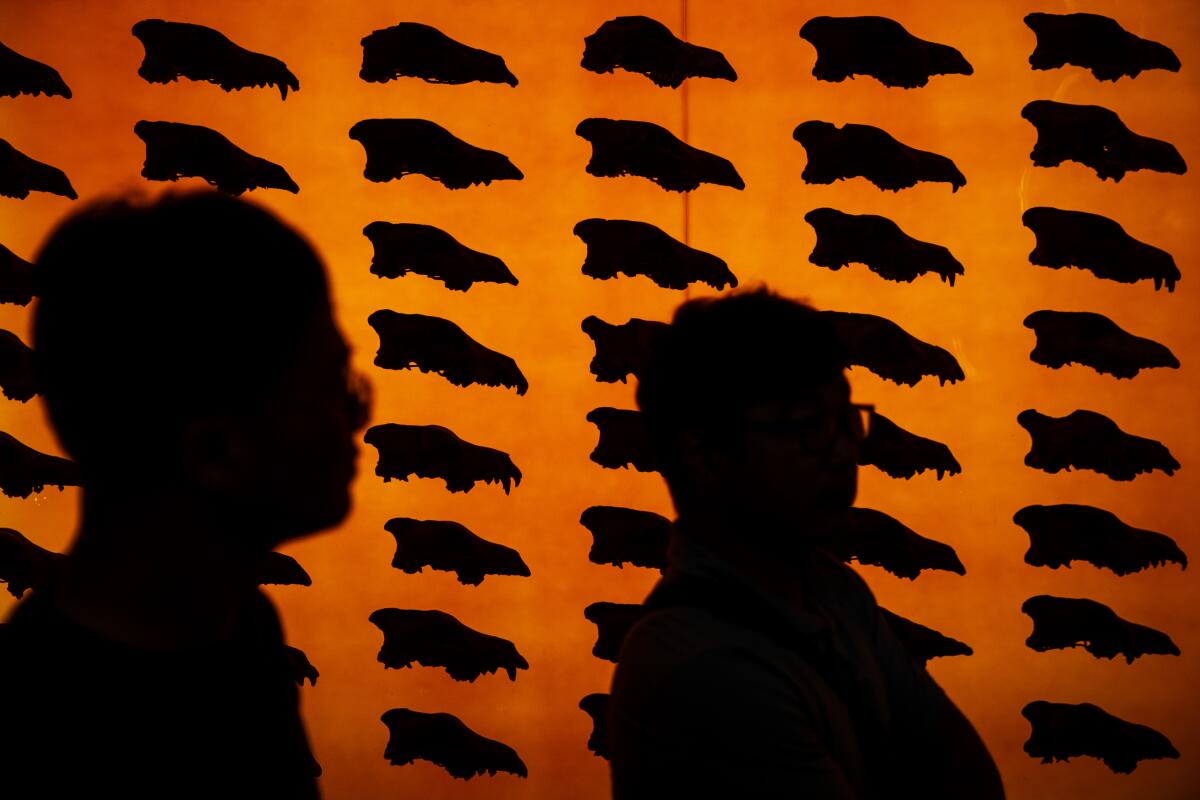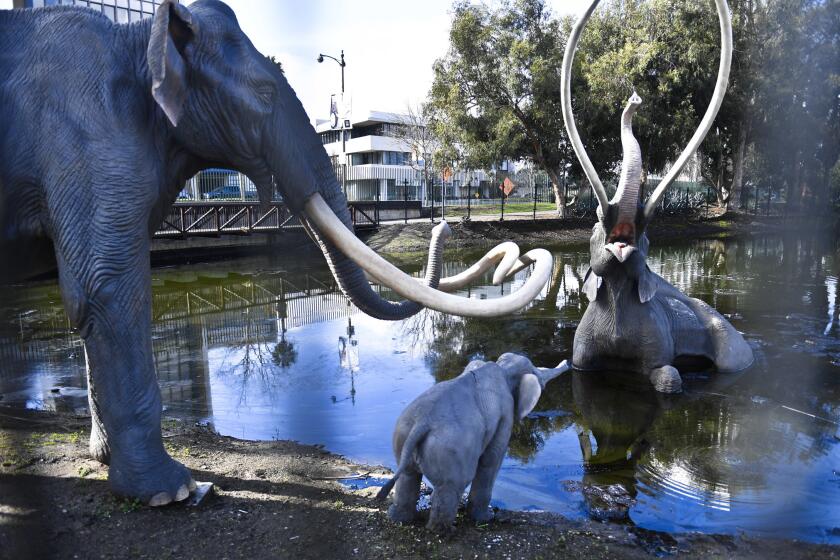Mammoth news! La Brea Tar Pits chooses its design team

Los Angelesâ beloved mammoths will not be going extinct.
Which is to say, the trio of fiberglass mammoths that have inhabited the Lake Pit at the La Brea Tar Pits since the late 1960s â and have concurrently functioned as paleontological science lesson, municipal landmark, pop culture icons and L.A.âs most wrenching work of public art â are keeping their outdoor home.
Late this summer, their future appeared uncertain. At the time, the Natural History Museums of Los Angeles, the entity that manages the tar pits, presented three architectural proposals for a redesign of the tar pits park, museum and research site by a trio of international firms: Dorte Mandrup, Weiss/Manfredi and Diller Scofidio + Renfro. The latter groupâs plan called for the removal of one of Los Angelesâ most striking scenes â a mama mammoth eternally slipping into the tar lake as its baby cries out by the shore.
On Wednesday afternoon, the museumâs board announced the winning plan.
The job goes to Weiss/Manfredi, the New York-based firm behind the critically acclaimed Olympic Sculpture Park in Seattle. Its proposal clarified the parkâs many functions, preserved the â70s-era George C. Page Museum, added a new exhibition wing and expanded the lawn area. And not insignificantly: It kept L.A.âs most famous proboscideans right where theyâve always been.
âIt was across the board,â said Lori Bettison-Varga, president and director of the Natural History Museums of Los Angeles, of the selection. âThere was consensus among the jury, public feedback, the staff and the volunteers. This was an unusual process â it was creative and rigorous. We are delighted to select Weiss/Manfredi.â
âThis is a project of a lifetime,â said Marion Weiss, one of the firms co-founders, by telephone from New York. âI canât think of any project in the world that has the richness, the depth, the there-ness of this area, and the paradoxical nature of all of this being in one place.â
âThere is no city that is more quintessentially American than L.A.,â added co-founder and principal Michael Manfredi. âAnd there is no site more quintessentially L.A. than the La Brea Tar Pits.â
And within the tar pits, there is no sight quite like the mammoths. âItâs something so iconic,â says Manfredi.
The George C. Page Museum needs an update, but the life and death tableau near the corner of Wilshire and Curson should stay the same.
The other two proposals considered called for a more extensive rethinking of the tar pits site.
Danish firm Dorte Mandrupâs design maintained the bones of the Page Museum structure but gutted the building and added a story. New York firm Diller Scofidio + Renfro had the most radical proposal, which would have replaced the Page with an entirely new structure composed of overlapping plates. That plan would have also plucked the mammoths out of the pit and placed them inside a gallery.
There is no city that is more quintessentially American than L.A. And there is no site more quintessentially L.A. than the La Brea Tar Pits.
— Michael Manfredi, architect
The Page Museum, designed by architects Willis Fagan and Frank Thornton, and completed in 1977, is hard-pressed for exhibition space and sometimes leaks. Wayfinding around the tar pits can be confusing, with visitors frequently asking for directions â even as they stand right before the museum. Pedestrian connections to Wilshire Boulevard to the south and 6th Street to the north are awkward, as are the links to the soon-to-rebuild Los Angeles County Museum of Art, which sits right next door.
Moreover, the active dig sites â which over the decades have turned up a bounty of paleontological artifacts, such as the fossil remains of dire wolves â are more off-putting than inviting.
âSome people say they enter on site and they think itâs a construction site,â Weiss said. âThey donât realize thatâs where the science is happening.â
Of the three plans submitted, Weiss/Manfrediâs did the most to preserve the most beloved aspects of this unusual urban park while making numerous additions.
Manfredi says the Lake Pit, with its cluster of mammoths, along with the mountain-esque Page Museum, are âso embedded in the lore of Los Angeles.â Rather than rethink them entirely, he said their firm preferred to make them a focus: âLetâs start with whatâs unique and really build on that.â
Their proposal maintained the architecture of the Page Museum and its gently sloping berms and added a new exhibition wing to the northwest to better accommodate the ever-expanding fossil collection. To make the famously reclusive museum more accessible, the architects proposed cutting away at a piece of the berm to reveal a sliver of the galleries inside.
A series of proposed pathways â which the architects describe as âLoops and Lensesâ â circle the Lake Pit at the corner of Wilshire and South Curson Avenue, the central lawn area (an important outdoor space for the neighboring community) and the dig sites on the north end, weaving together the myriad elements in the park.
Plus, a curved bridge over the Lake Pit adds drama and a place from which to contemplate the mammoths in what is ultimately one of L.A.âs weirdest, most ersatz sites: a fake mammoth sinking into a tar pit that isnât really a tar pit but a man-made lake â an urban fiction that ultimately tells the true story of how the La Brea Tar Pits came to be such a rich fossil site. (A lot of animals got stuck in muck.)
âYou need a lot of different skills to approach a project like this,â says Christopher Hawthorne, chief design officer for the city of Los Angeles and former Times architecture critic, a member of the five-person jury that reviewed the designs and offered recommendations to the museum. âThe layers of history â geological, environmental and political history that converge on this site. But you also need a sense of irony, a sense of camp and pop culture. And you have to weave all of these together.â
âWeiss/Manfredi brought the right combination of re-imagining the site,â he adds, âbut also understanding what the site means to Angelenos.â

Bettison-Varga said the architects have put together a team that includes thinkers with âa deep connection to the site,â who will be âthinking about immersive experiences and how you tell the story and bring it to life.â
In addition to their 40-person studio, Weiss/Manfredi will collaborate with experiential designer Karin Fong of Imaginary Forces, horticulturalist Robert Perry, paleobotanist Carole Gee, artist and naturalist Mark Dion, designer Michael Bierut of the graphic design firm Pentagram, and local architect Brenda Levin, of Levin & Assoc., known for her work on famed Los Angeles buildings such as Frank Lloyd Wrightâs Hollyhock House and the Bradbury Building.
âCarole Gee is a paleobotanist who interned at the La Brea Tar Pits and is now world renowned,â said Manfredi. âAnd Robert is sensitive that we are entering a new era of extreme heat and little water, so his perspective will be very valuable. And Brenda is a highly regarded architect in saving and preserving important projects to Angelenos. She knows the scene in Los Angeles.â
Not to be overlooked are Weissâ own personal connections to the park.
Born in Los Altos, Calif., her family made excursions to the L.A. area when she was a girl. âMy motherâs background is geology and geography,â she said. âSo our trips to Southern California were almost less about Disneyland and almost more about La Brea. There were classrooms being had.â
âSeeing the methane bubbles and knowing that it was alive and knowing that there was something ancient below the surface made it so weird and so magical,â she adds. âAnd that it existed in Los Angeles, which is so quick to erase histories.â

Now that it has been selected, the team, in collaboration with leadership at the Natural History Museums, will spend the next year turning its initial proposal into a more thought-out conceptual design.
âFrom there, we would move to schematic design,â said Bettison-Varga. âThe fundraising will be a part of that picture.â She hopes that by early 2021, they will have an estimate on cost.
âWeâll be spending about a year on a master plan, which will allow us, after the intensity of the competition, to quietly work with the museum and museum staff and interested stakeholders,â said Manfredi. âIt will be quiet listening and fact gathering and weâll start testing out variations on the ideas that we presented.â
Beyond the architecture, itâs an opportunity to consider the larger narratives about the fossils of the La Brea Tar Pits and the era in which they were formed.
âThe Pleistocene era was an era of extreme climate change,â said Manfredi. âItâs unbelievably relevant.â

More to Read
The biggest entertainment stories
Get our big stories about Hollywood, film, television, music, arts, culture and more right in your inbox as soon as they publish.
You may occasionally receive promotional content from the Los Angeles Times.












